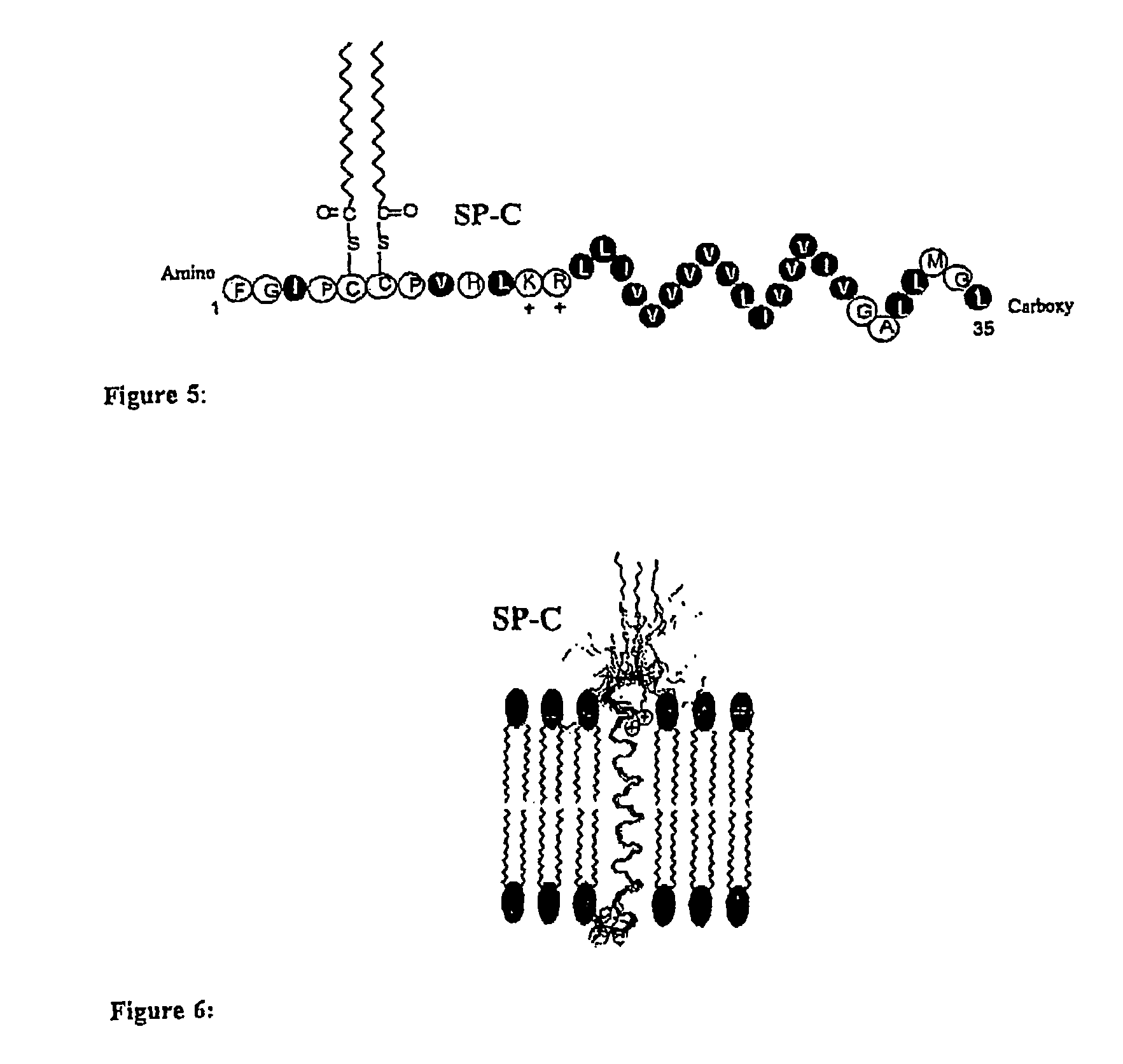Polypeptoid pulmonary surfactants
a technology of pulmonary surfactants and polypeptoid, which is applied in the direction of phosphorous compound active ingredients, peptide/protein ingredients, peptide sources, etc., can solve the problems of inability to rapidly respread, inconformity of mammalian lungs, and inability to meet the requirements of mammalian lungs, etc., to achieve enhanced bioavailability, stable in vivo, and low dose
- Summary
- Abstract
- Description
- Claims
- Application Information
AI Technical Summary
Benefits of technology
Problems solved by technology
Method used
Image
Examples
example 1
[0151]The peptoid-peptide chimerae and peptoid SP-mimics were synthesized on a PE-Biosystems model 433A® automated peptide synthesizer using the sub-monomer and monomer protocol, with the sidechains shown in the sequence mentioned above. Synthesis was on 0.25 mmol Rink amide resin (substitution, ca 0.5 mmol / g, NovaBiochem, San Diego Calif.). After removal of the first Fmoc protecting group from the resin, the following 90-minute monomer addition cycle is performed: the amino-resin is bromoacetylated by adding 4.1 mL of 1.2M bromoacetic acid in DMF plus 1 mL of N,N′-diisopropylcarbodiimide. The mixture is vortexed in the synthesizer's reaction vessel for 45 minutes, drained, and washed with DMF (4×7 mL). 6 mL of 1M primary amine in NMP is added to introduce the desired sidechain and agitated for 45 min. Depending on the difficulty of incorporation of the primary amine, the coupling time may be extended to 2 hours. In the case when an Fmoc-protected monomer is introduced, an alternati...
example 2
[0152]The crude peptoid of Example 1 was dissolved in acetonitrile / water and analyzed by gradient reversed-phase HPLC on C4 packing (Vydac, 5 μm, 300 Å, 4.6×250 mm). A linear gradient of 0-100% B in A was run over 60 min at a flow rate of 1 mL / min (solvent A=0.1% TFA in water, B=0.1% TFA in isopropanol) at 60° C. Preparative HPLC was performed on a Vydac C4 column (15 μm, 300 Å, 10×250 mm) using the same solvent system; peaks were eluted with a linear gradient of 0-100% B in A over 45 min at 8 mL / min. Depending on the hydrophobicity of the molecule alternative gradients are used with different mobile phases including acetonitrile and water. The samples were purified to >99%. ES or MALDI-TOF mass spectroscopy was used to confirm chemical identity. Circular dichroism spectroscopy (CD) was carried out on a JASCO J-720 instrument. 60 μM samples were analyzed in a cylindrical quartz cuvette with a path length of 0.02 cm (Hellma, Forest Hills, N.Y.). Surface activity measurements were per...
example 3
[0153]The surface pressure-area isotherms of SP-C mimics as measured on a Langmuir-Wilhelmy Surface Balance (“LWSB”) are shown in FIG. 9. The samples were prepared in chloroform:methanol (1:1) and spread on the trough filled with water (subphase). The peptoid-peptide chimera SPCM1 and SPCM3 have comparable (but not identical) surface activities (high collapse pressure) in comparison to the SP-C peptide as found in literature. The activity of the aforementioned SP-C mimics in combination with phospholipids is shown in FIGS. 10A-B. The admixture is composed of DPPC:DPPG (7:3) with 0.4 mole % of SP-C mimics. The results show that the addition of the mimic improves the surface activity as indicated by the decrease in hysteresis between the first and second compression-expansion cycles. This is significant because it suggests that less material is being lost into the subphase, which has been an issue associated with films composed of lipids alone.
PUM
 Login to View More
Login to View More Abstract
Description
Claims
Application Information
 Login to View More
Login to View More - R&D
- Intellectual Property
- Life Sciences
- Materials
- Tech Scout
- Unparalleled Data Quality
- Higher Quality Content
- 60% Fewer Hallucinations
Browse by: Latest US Patents, China's latest patents, Technical Efficacy Thesaurus, Application Domain, Technology Topic, Popular Technical Reports.
© 2025 PatSnap. All rights reserved.Legal|Privacy policy|Modern Slavery Act Transparency Statement|Sitemap|About US| Contact US: help@patsnap.com



